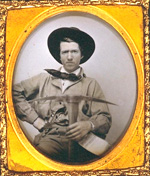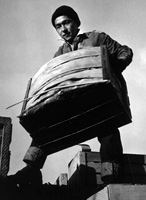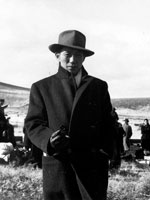Material culture is at the heart of the work of the Japanese American National Museum (JANM). Using material culture, we fulfill our mission of promoting the understanding and appreciation of America’s ethnic and cultural diversity by sharing the Japanese American experience. JANM has a permanent collection of over 60,000 photographs, documents, crafts, artwork, and moving images. These artifacts make up the material culture that illustrates and substantiates the history of one ethnic group in the United States.
One of the largest artifacts in our collection is a barrack from a World War II-era American concentration camp. During World War II this barrack was located in Heart Mountain, WY, and housed Japanese American families forcibly removed from the West Coast. It is now on display as part of Common Ground: The Heart of Community, JANM's ongoing exhibition covering the history and culture of Japanese Americans from the 1880s to the present.
Within the exhibition the barrack confronts people with the reality of the experience of over 110,000 people of Japanese descent who were confined in one of 10 camps run by the United States government. For Japanese Americans who were once confined in similar barracks, seeing this artifact often serves as an emotional reminder of a difficult past.
. . . the barrack confronts people with the reality of the experience of over 110,000 people of Japanese descent who were confined in one of 10 camps run by the United States government.
Each year, over 20,000 students in Los Angeles visit JANM and are able to stand inside this barrack. They listen to the volunteer docents' first-person stories about life during World War II. Material culture brings history to life so when students see the gaps between the barrack floorboards and hear the volunteers recount the mass removal and confinement without due process, they often respond by saying, "That's not fair."
An opportunity for dialogue opens when students ask how this could have happened to the Japanese Americans. This allows us to share not only the World War II experience, but also the pre-war discrimination, the community's post-war struggles to get back onto its feet, and the coalition that fought for and in 1988 achieved redress from the United States government. A tour that began in a 70-year-old barrack can become a discussion about race-based discrimination and the struggle to redress a constitutional wrong.
A tour that began in a 70-year-old barrack can become a discussion about race-based discrimination and the struggle to redress a constitutional wrong.
The barrack from Heart Mountain is one example of an object's ability to teach and invite thoughtful conversation. Like many other museums, we are beginning to experiment with ways to increase the accessibility of more of our artifacts. This school year we have introduced two new school programs. Digital Speakers Bureau is designed to allow real-time, Web-based dialogue between docents and students who cannot visit the museum. Object Analysis with the Education Collection is for students who live in the Los Angeles area and are interested in hands-on analysis of a subset of JANM's collections. Additionally we have begun to upload 30- to 60-second video clips of volunteers sharing stories that relate to artifacts from our collection and have a handful of online collections.
Material culture encourages students to think critically about the real-life lessons that this experience holds for us all. While the Heart Mountain barrack evokes deeply personal memories for many Japanese Americans, it also stands as a general warning against the discrimination, mass removal, and incarceration of any one ethnic group. The barrack from World War II reminds us that—now and in the future—it is our individual and collective responsibility to uphold constitutional rights for all.


